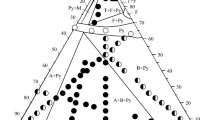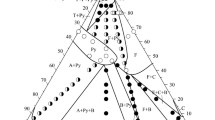Abstract
Zirconia can be stabilized by incorporation of nitrogen. The phase relationships in the ZrO2-rich part of the system ZrO2–Zr3N4 have been investigated using high-temperature X-ray methods. At temperatures above 1000°C, a tetragonal and a cubic phase with randomly distributed vacancies exists, depending on the amount of incorporated nitrogen. This high-temperature behaviour is similar to that of systems like ZrO2–Y2O3, which is another indication for the important role of anion vacancies in zirconia systems. Below 1000°C, β-type phases with an ordered arrangement of anion vacancies are stable.
Similar content being viewed by others
References
V. S. Stubican, “Advances in Ceramics”, Vol. 24, “Science and Technology of Zirconia III”, edited by S. Somiya, N. Yamamoto, H. Yanagida (The American Ceramic Society, Westerville, 1988) p. 71.
P. Duwez, F. Odell and F. H. Brown, J. Am. Ceram. Soc. 35 (1952) 107.
C. F. Grain, ibid. 50 (1967) 288.
V. S. Stubican and S. P. Ray, ibid. 60 (1977) 534.
H. G. Scott, J. Mater. Sci. 72 (1977) 311.
V. S. Stubican, R. C. Hink and S. P. Ray, J. Am. Ceram. Soc. 61 (1978) 17.
J. R. Hellmann and V. S. Stubican, ibid. 66 (1983) 260.
C. Pascual and P. Duran, ibid. 66 (1983) 23.
J. C. Gilles, Bull. Soc. Chim. Fr. 22 (1962) 2118.
R. Collongues, J. C. Gilles, A. M. Lejus, M. Perez, Y Jorba and D. Michel, Mater. Res. Bull. 2 (1967) 837.
Y. B. Cheng and D. P. Thompson, Special Ceram. 9 (1992) 149.
Idem, J. Am. Ceram. Soc. 76 (1993) 683.
M. Lerch, ibid., in press.
M. Lerch, F. Krumeich, and R. Hock, in “Transformation Kinetics and Reactivity of Solids”, edited by P. Grange et al., Louvain-la-Neuve, (1995) p. 123.
R. Hock, M. Lerch, K. S. Knight and H. Boysen, Z. Kristallogr. Suppl. 9 (1995) 298.
M. Lerch, R. Hock and E. FÜglein, ibid. 9 (1995) 193.
M. Lerch, L. Jacobsen and G. MÜller, ibid. 8 (1994) 256.
R. C. Garvie and P. S. Nicholson, J. Am. Ceram. Soc. 55 (1972) 303.
M. Lerch, D. Walter, O. RahÄuser, W. Laqua and K. S. Knight, Z. Kristallogr. Suppl. 9 (1995) 305.
M. Yashima, S. Sasaki, M. Kakihana, Y. Yamaguchi, H. Arashi and M. Yoshimura, Acta Crystallogr. B50 (1994) 663.
J. W. Adams, H. H. Nakamura, R. P. Ingel and R. W. Rice, J. Am. Ceram. Soc. 68 (1985) 228.
Author information
Authors and Affiliations
Rights and permissions
About this article
Cite this article
LERCH, M., RAHAUSER, O. Subsolidus phase relationships in the ZrO2-rich part of the ZrO2–Zr3N4 system. Journal of Materials Science 32, 1357–1363 (1997). https://doi.org/10.1023/A:1018521026557
Published:
Issue Date:
DOI: https://doi.org/10.1023/A:1018521026557




